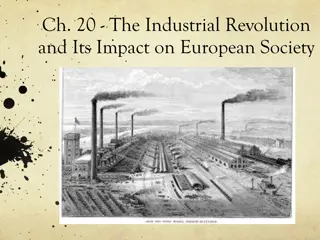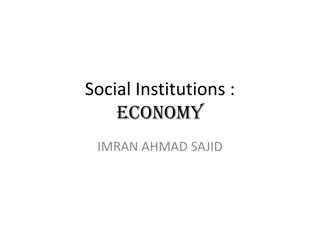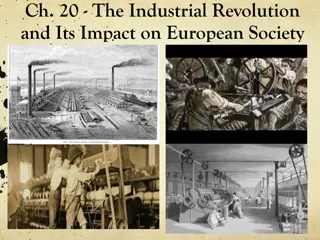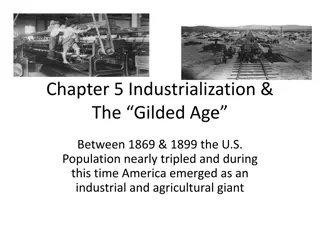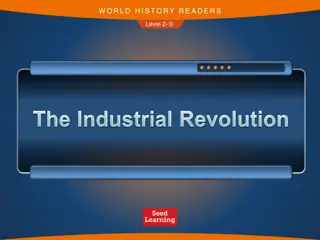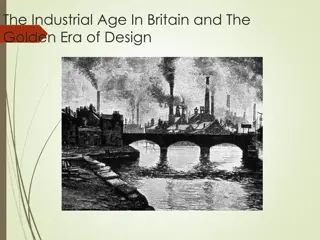The Impact of Industrial Revolution on Society
The Industrial Revolution, spanning from 1760 to 1870, revolutionized manufacturing processes, transitioning from hand production to machines, introducing new chemical and iron production methods, and the use of steam power. It began in England and caused radical societal changes, leading to the rise of factory systems and the development of machine tools. Factors leading to the revolution included agricultural surplus, mercantilism, availability of raw materials, scientific inventions, strong property laws, and a government that encouraged transportation. Inventions such as the Flying Shuttle, Spinning Jenny, and power loom transformed the textile industry, spurring and sustaining the revolution.
Download Presentation

Please find below an Image/Link to download the presentation.
The content on the website is provided AS IS for your information and personal use only. It may not be sold, licensed, or shared on other websites without obtaining consent from the author. Download presentation by click this link. If you encounter any issues during the download, it is possible that the publisher has removed the file from their server.
E N D
Presentation Transcript
WHAT IS INDUSTRIAL REVOLUTION Industrial Revolution was the transition to new manufacturing processes from about 1760-1870. It brought radical changes to our society. THE TRANSITION INCLUDES; going from hand production methods to machines, new chemical manufacturing and iron production, the increase use of steam power, the development of machine tools and the rise of factory system. it began in England and later spread to France, Germany, Netherlands,Austro/Hungary and other nations empires. The Industrial revolution is continuing till this days in many ways.
THE PRECEDING MILLENIA Farming was the main occupation of majority of people The lived closed to food sources all commodities were local, foreign goods were a rare luxury Production of goods was for use rather than profit Weapons which kill few people at once Life expectancy 35 years Travel and communication non existence or extremely low.
FACTORS LEADING TO INDUSTRIAL REVOLUTION IN ENGLAND Agriculture surplus in England due to new techniques in farming- revolution of 17thcentury. Mercantilism Mercantilism: : trading accumulation of wealth. The long coastline- no region is far away from sea port. This facilitate the procurement of raw materials. Semi skilled workers readily available Abundance of coal and Iron The Agriculture for profit and
A government that encouraged transportation and used its navy to protect British trade The administrative and military expenditure of England was lower than other monarchies of Europe at that time. improvements in Resources in the form of colonies- cheap raw materials and ready market Scientific invention were facilitated and promoted Banks and banking system Strong Property laws and Political Institution Low population and high cost labour Incentive to invent and adopt machines
INVENTION THAT SPURRED AND SUSTAINED THE REVOLUTION Textile industry was the first to be affected by IR. It was completely mechanized by 1830s. John kay s Flying Shuttle - weaving Industry Spinning Jenny - enabling spinning 100 of yarns The power loom
STEAM ENGINE- JAMES NEWCOMMEN JAMES NEWCOMMEN (1705) JAMES WATTS JAMES WATTS STEAM ENGINE 1769- HEAT ENERGY INTO MECHANICAL ENERGY
STEAM LOCOMOTIVES- RAILROADS, STEAMBOATS
Stephenson rocket 1810 First train 1830 By 1860 most of the parts of England was connected with railway line
TELEGRAPH WAS INVENTED IN 1835 Joseph Henry and Edward Davy
IMPORTANCE OF COAL IN INDUSTRIAL REVOLUTION ABUNDANT IN ENGLAND CHEAPER THAN OTHER HEAT RESOURCES ( WOOD, FOREST WERE DEPLETED) IRON PRODUCTION AT COMMERCIAL LEVEL WAS DONE ONLY DUE TO LARGE QUANTITY OF COAL RUDIMENTARY STEAM ENGINE WAS FIRST INVENTED TO PUMP WATER OUT OF THE COAL MINES. IT LEAD TO REVOLUTION IN MACHINE TOOLS, TRAINS AND OTHER INDUSTRIES
POSITIVE IMPACT OF IR FACTORY SYSTEM STANDARDISATION OF WORK METHOD AND PROCESSES AND MASSIVE PRODCTION QUANTITITIES MEANS OF COMMNICATIONATION AND TRANSPORTATION ROADS, RAILWAYS, TRACK, CANNELS. URBANIZATION NO MORE HUNGER AND FAMINE
NEGATIVE IMPACT Capitalism Capitalism: : resources of production owned by few Exploitation Exploitation of of workers protective gear, hazardous and unhygienic working conditions (SLUM AREAS WERE FORMED) often lead to epidemic like cholera Traditional weavers and workers were wiped out by machines Child labour flourish because it was cheaper to employ children and women also FACTORY ACT 1830 IN ENGLAND MORE DEMAND FOR COLONIAL EXPANSION philosophy of profit maximisation, workers- - long working hours, no
De- Industrialization of colonies like India Population increases- growth of slums, low wages Europe population: 140 mil in 1750 463 mil in 1914 Pollution- health, environment concern Dominance of European nations over world affairs in 18thand 19thcentury
The many negative impact of Industrialisation led to growth of different ideology in the society- Socialism- a model which believe in equality, where people collectively own and control the means of production and equal distribution.
PHASES OF INDUSTRIAL REVOLUTION 1760-1850: mechanization of textile industry, mining, steam engine, and its application in transport 2ndphase late 19thcentury: scientific invention take centre stage, steels, chemicals, growth mass production (ASSEMBLY LINE) , USA and Germany lead this phase. 3RDPhase late 20thcentury- ongoing Communication, technology, internet, energy robotic, digitization of manufacturing 3d printing ]
Industrialization in India Industrialization in India Industrialization in India can well be marked under two heads viz., Pre-British Period and the Evolution of Modern Industry. Pre Pre- -British period British period India was famous for her handicrafts right from Pre- British times. During the Mughal Period, India had a considerable variety of arts and handicrafts. The products commanded wide range of foreign markets. At that time no other country produced products that could be imported to India in exchange for cotton and silk goods which were in world-wide demand. Europe had to pay in billions for the increasing volume of Indian exports.
INDUSTRIALISATION IN INDIA Industrial Revolution in England has propelled industrialisation not elsewhere also. Whenever there industrilisation in India, the colonial state is brought to the centre stage. Empire often cite investments in infrastructure etc as laying the ground for further industrilisation. only in England but is discussion on examples of British
The other arguments highlights the disastrous results of colonialism on the indigenous economies, completely taking it out of competitive edge it had in textile industry. This argument was particularly favoured by the nationalist Dadabhai Naoroji s Drain of Wealth and R.C. Dutt s work of Economic History of India had become works that were part of the nationalist historiography. The nationalists argued that competition with cheap British mill cloth drove Indians out of the handloom industry and into agriculture.
Another argument which does not agree with notions that India was stagnant till the British came and took over.
India was also famous for jewellery of exquisite quality which were made out of gold and silver and also those which were made out of copper, brass and bell-metal. Many urban centres were famous in those days for carving work in ivory, wood, stone and marble. Though the quality of Indian goods was high, in England they were treated as 'plague' shortly. Prohibitory laws were passed in 1701 and 1720 against the use of the Goods.
IMPORTANT REASONS FOR THE DECLINE OF INDIGENOUS INDUSTRIES WAS THE INDUSTRIAL REVOLUTION OF ENGLAND. The cotton industry was the first to be revolutionised by the new process. India was reduced to the status of a colonial dependency. Imperialism set out to economy and a substantial part of native handicrafts. Prohibitory duties were imposed on Indian goods because, up to 1813 the silk and cotton goods of India were sold in the British market at a price from fifty to sixty percent lower than the price of those fabricated in England. destroy the independent
By 1880, the decline of handicrafts were nearly complete and the mass of Indian handicrafts men had no alternative means of livelihood. Very few Indian entrepreneurs started manufacturing business as British polices did not favour them. There were however several business communities who were initially the collaborators and middlemen with the British, like the Parsis and Marwaris who ventured in to setting up industries. The Marwaris of Calcutta moved from being traders to industrialist in the jute business.
one may realize that the gradual transformation of India into a single national unit and the growth of great mercantile centres were the impacts of British rule. The introduction of the English language was another factor which helped the training of a large number of young Indians. This was necessary for mastering modern scientific subjects which were necessary for gaining the technical knowledge required for industri.es and also in business
The abolition of the monopoly of the East India Company in 1833 provided a big opportunity for the English merchants to develop trade and industry in India. Foreign capital and enterprise flowed into plantations and monopolistic industries such as jute and railways. Another major factor which contributed to this was the political developments in India and abroad. For instance, the American civil war gave a great impetus to the cotton industry and the World War I to the iron and steel industry.
During the Second World War period, though the actual war was not fought on Indian soil as such, India stood as a major supply base of war materials for the Middle Eastern and South Eastern theatres of war. But the capacity for the production of war materials in India was limited. Therefore, a few new industrial enterprises were set up. Thus, some new important industries started production during the war period. These include manufacture of transport equipment, chemicals, metals and mechanical industries like diesel engine and pumps. There was considerable increase in the number of new industries.
During the immediate post war years, the industrial production was low and stagnant. Almost all industries registered lower output and the situation was serious with respect to cotton, textiles, cement, iron and steel, sugar and paper. 1947 marked a serious threat to the nation as such, so also to the industrial activities. The partition of India brought about a complete disruption of the industrial and system, which had for long, lived as a single united economic unit. economic
INDUSTRILISATION IN POST-INDEPENDENT INDIA The economic path India took, especially under the leadership of Jawaharlal Nehru the new Prime minister of India. The link between colonialism and underdevelopment was firmly established . This history made Indian leaders wary of international free trade. Nehru who was inspired by Fabian socialism and by the Russian example decided to adopt a socialist pattern of economic development. Thus in the initial phase of economic development saw setting up heavy industries and the construction of dams. Five Year Plans After independence, India opted to have a centrally planned economy to ensure an effective and equitable allocation of national resources for the purpose of balanced economic development. The idea of planning was taken from Russian centralized planning system. Indian Economy is based on the concept of planning. This is carried through her Five-Year Plans, developed, executed and monitored by the Planning Commission. After liberalisation, the emergence of a market economy with a fast growing private sector, planning has become indicative, rather than prescriptive in nature.
Gandhi: Swadeshi and Khadi Gandhi believed that India s progress was tied up with its villages. He was distrustful of the overarching powers of the state and conceived of a series of village republics for India. He was not for industrilisation which would destroy traditional handicrafts and artisans and industries associated with them. He strongly believed the concept of self reliance or swadeshi. This meant that we, as Indians should find sustenance in our efforts labour and intellect derived from the people themselves. Khadi-the hand spun cloth symbolized to him the spirit of swdeshi.

 undefined
undefined









